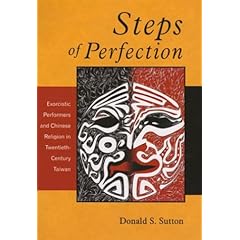Steps of Perfection (part 1)
/ Before our former vice president invented the internet I had a habit of reading thick scholarly books. Now, I have to go hide out in the mountains for a few days or feign illness if I want to get through something really erudite.
Before our former vice president invented the internet I had a habit of reading thick scholarly books. Now, I have to go hide out in the mountains for a few days or feign illness if I want to get through something really erudite.While I love these books they are the opposite of juicy. That being said, if you have the discipline or isolation to really read a book, Steps of Perfection: Exorcistic Performers and Chinese Religion in Twentieth-Century Taiwan
This book falls in the the category of books which are so scholarly they hint at the juicy ground breaking ideas rather than say them outright. With a book like this you have to read the footnotes or you might miss the best part of the argument.
The book is about a type of Chinese martial dance called Jiajiang which runs roughshod over all Western categories of conceptualization to such an extent that it takes a whole book just to say what the dance is. Sutton took a lot of video in 1993 while researching this book, and I would give one of my best swords to see the best of that tape. The book should have a DVD, but I guess the author didn't have proper releases or something (he hasn't answered my emails on this question so I don't know.)
(Here is a google video search for Jiajiang, someone with better Chinese language skills can probably find some better stuff, wink, wink? )
The scope of this book appears on the face of it to be narrow, but the implications of the book for conceptualizing Chinese martial arts, medicine and religion are huge. I'm going to spend a few days talking about this book so let me spin off for a minute to get you oriented.
The long history of the survival of various civilizations could be viewed as the project of getting nice people to fight. There are now and there have always been, humans who love killing. The duty of the civilized and the free is to see to it that people who love killing do not get into positions of power; and that in the event that such people do get into positions of power, they get taken out.
How that happens in each and every civilization or era is different. Historically in China there were several layers of organized armed groups which shared the duty of keeping power civil: Standing armies, militias, small professional forces maintained by a magistrate, and local family protection societies.
How do you get people to support the common good in an environment in which there are competing interests. Part of what this book deals with is how people are connected through ritual, and how various needs of the different layers of society find their way into ritual expression. Yikes that's a mouthful.
The jiajiang martial dancers share some of the important roots of modern martial arts. Sutton maps a spacial environment in which different ways of organizing reality overlap and interact.
In one corner you have Daoist ritual which is done in private. Orthodox Daoists by definition do not subordinate to deities. They perform rituals with cosmological forces that go unseen by the general public, but exist in peoples' imaginations. People know about them, even if they don't see them. Daoists are part of a bigger landscape of ritual relationships, and they represent a particular approach to life.
In another corner are the representatives of a government which has its own rituals. Historically, for instance, magistrates would arrive in an area with a sedan chair and an entourage, sometimes huge processions demonstrating real power.
In another corner there are the trance-mediums who publicly speak for and with the gods, controlling and healing people with other worldly powers, spells, and self-mortification.
 Then there is the corner of medicine and elite scholarly exchange which merges in to the much larger realm of commerce.
Then there is the corner of medicine and elite scholarly exchange which merges in to the much larger realm of commerce.And then there is the popular realm where local elites interact with the guy who drives the gravel truck. Where martial artists train and perform gongfu, where school kids learn martial dance routines for a two day festival procession that twists around visiting local temples and homes. Where the presence of the dead is felt in places people frequent and exorcism is a regular occurrence. A place where gods and demons possess not just mediums, but the guy you went to high school with.
The fighting dream dances of Taijiquan and Baguazhang came out of this world, and like everything else that grew up in Chinese society, these arts have a limb in each corner.

 This is a really
This is a really  I've got lots of material lined up to write about but much of it is in the category of "mind blowing" revelation and reinterpretation, so I want to really take the time to do it right. That means a lot of metaphorical heavy lifting, perhaps long posts broken up into sections. So I'm offering something a little lighter for tonight.
I've got lots of material lined up to write about but much of it is in the category of "mind blowing" revelation and reinterpretation, so I want to really take the time to do it right. That means a lot of metaphorical heavy lifting, perhaps long posts broken up into sections. So I'm offering something a little lighter for tonight. Building up strength cuts off fluid circulation, and reduces sensitivity. The more strength you build, the less ability you have to continuously engage every millimeter of your body. Our bodies are dynamic enough that we can be more like tigers and octopuses, or we can be more like oxen and yaks. Which type of animal you are like depends a little on personal preference and a lot on fate. If you have the fate to practice internal martial arts than you can cultivate weakness like a tiger or an octopus.
Building up strength cuts off fluid circulation, and reduces sensitivity. The more strength you build, the less ability you have to continuously engage every millimeter of your body. Our bodies are dynamic enough that we can be more like tigers and octopuses, or we can be more like oxen and yaks. Which type of animal you are like depends a little on personal preference and a lot on fate. If you have the fate to practice internal martial arts than you can cultivate weakness like a tiger or an octopus. One of the most common ways to injure ones back is to reach for a heavy pot on the back of the stove. If you follow the Two Finger Rule you'll be sure to pull that pot of black-eyed peas and bacon to the front burner before trying to pick it up.
One of the most common ways to injure ones back is to reach for a heavy pot on the back of the stove. If you follow the Two Finger Rule you'll be sure to pull that pot of black-eyed peas and bacon to the front burner before trying to pick it up. The word orthodox is pretty common. It means a right way of thinking or a correct standard way of understanding.
The word orthodox is pretty common. It means a right way of thinking or a correct standard way of understanding.
 I would say my fate has been good, even princely perhaps. Most people don't want to believe in fate. They figure only silly people and Asians believe in fate. What is fate?
I would say my fate has been good, even princely perhaps. Most people don't want to believe in fate. They figure only silly people and Asians believe in fate. What is fate? There is a common taijiquan metaphor that practice is like making silk brocade interwoven with golden threads.
There is a common taijiquan metaphor that practice is like making silk brocade interwoven with golden threads. I was delighted that
I was delighted that 
 First of all, since I slept most of the day, here is a repost from September about
First of all, since I slept most of the day, here is a repost from September about  In Chinese it's not correct to say "I am studying Taiji (or Tai Chi)." First of all
In Chinese it's not correct to say "I am studying Taiji (or Tai Chi)." First of all  George Xu used to tell us stories about the Wild East. Often he was a character in these stories, and honestly I think they were true stories, but more often than not he seemed to be the cowboy with the white hat. (He was the good guy in morality tales that may or may not have been so black and white.)
George Xu used to tell us stories about the Wild East. Often he was a character in these stories, and honestly I think they were true stories, but more often than not he seemed to be the cowboy with the white hat. (He was the good guy in morality tales that may or may not have been so black and white.)